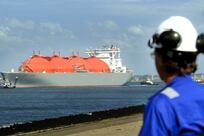It is minus 27°C at Russia’s nickel mining centre of Norilsk, minus 34° at Alaska’s Prudhoe Bay oilfield and minus 47° in the Yukon, the gold rush area of a century ago. All are enveloped in the long Arctic night. But it doesn’t mean they are being ignored.
The scramble for Arctic resources has attracted great recent interest from media and military, corporations and commentators. The Russian president, Vladimir Putin, announced this month that his country would reopen its military base on the remote Novosibirsk Islands. Thirty Greenpeace protesters, who in September were detained after attempting to board the Prirazlomnaya oil platform, were released by Russia after an amnesty. And the minerals minister of Greenland, which recently voted to allow mining for uranium and rare earth metals, visited China for talks.
The Arctic has all the elements of a grand story. Great-power competition between the United States, Canada and Russia has China as an interested bystander. Smaller nations – Greenland, Iceland and Norway – and indigenous peoples seek to secure their futures.
Energy – oil, gas, uranium, geothermal and hydropower – and minerals seem ever more vital for the world economy. Melting ice uncovers more resources and opens up new sea routes but threatens global climate disaster. The stark and beautiful landscape, and its photogenic polar bears, appear threatened by climate change and industrial activity.
But the thrill of novelty should not lead us to overplay the importance of the Arctic – and neglect more important 21st century arenas such as the factories of the Chinese littoral, the one and a half billion people of South Asia, the Arabian Gulf’s oil, or the US West Coast innovation hub.
The US geological survey estimated in 2008 the Arctic held 13 per cent of the world’s undiscovered oil and 30 per cent of its undiscovered gas. But this picture has now been changed by the emergence of shale gas and oil in more comfortable climes in the US, and probably onshore in West Siberia. Offshore Arctic resources will eventually play a significant role – but they will be costly, technically frustrating and slow to come to market.
From Dalian in China to Rotterdam in the Netherlands is about 48 days via the Suez Canal, but 35 days through the Northern Sea Route (north of Russia), saving time and fuel. As Arctic ice retreats, this route will become more attractive – particularly for shipping bulk such as ore, coal and oil.
But shipping is not just about distance. Storms, unpredictable remaining ice, the shallow draft of passages south of Russia’s Arctic islands, and the lack of port facilities and search-and-rescue make the Northern Sea Route more costly and less reliable. Just four ships sailed the route in 2010; in 2013, this had gone up to 71 – but the Suez Canal carries more than 17,000 annually.
Environmentalist campaigns against Arctic drilling, perhaps intentionally, muddle two issues. Climate change is a grave threat to the region’s ecosystems and communities, and ice melting can accelerate warming of the rest of the Earth. The local environmental effect of mineral extraction has to be carefully regulated – but a barrel of oil has the same effect on the climate whether from Alaska or Angola. And Arctic oil – or even better, gas – is preferable to Canada’s high-carbon oil sands.
Of course, there will be jostling for position and attempts to claim strategic or resource-rich ocean areas. But Russia and Norway have resolved their border dispute, the most significant for oil and gas.
Other potential tussles are in the deep, remote and still ice-covered central Arctic Ocean. So, like the petroleum-rich Caspian in the 1990s, the Arctic may be fascinating, a treasure trove for corporations, generals and scholars alike – but it is ultimately a sideshow.
Robin Mills is the head of consulting at Manaar Energy, and the author of The Myth of the Oil Crisis





